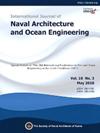Influence of transverse residual stress and welding defect on fracture performance of thick weld based on GTN damage model
IF 3.9
3区 工程技术
Q2 ENGINEERING, MARINE
International Journal of Naval Architecture and Ocean Engineering
Pub Date : 2025-01-01
DOI:10.1016/j.ijnaoe.2025.100654
引用次数: 0
Abstract
Welding residual stress (WRS) seriously affects the fracture performance of welded structures made of high-strength steel (HSS). Nevertheless, the influence mechanism of WRS on fracture performance remains unclear. In this study, a thick weld of Q690 HSS is fabricated, and experiments are conducted to test the tensile performance of the base metal (BM), welded metal (WM), and the welded joint. The Gurson-Tvergaard-Needleman (GTN) parameters for the thick weld are identified through experimental data and numerical simulation. Using transverse residual stress (TRS) and welding defects as initial inputs, the ductile fracture behavior of the thick weld is predicted through the identified GTN damage model. When TRS and welding defects are taken into account, the crack distribution shifts from the BM to the main WM and the back HAZ. The higher tensile stress in the WM, combined with welding defects, significantly reduce the fracture strength by accelerating the void growth and coalescence process.
基于GTN损伤模型的横向残余应力和焊接缺陷对厚焊缝断裂性能的影响
焊接残余应力(WRS)严重影响高强钢焊接结构的断裂性能。然而,WRS对裂缝性能的影响机制尚不清楚。本研究制备了Q690高速钢厚焊缝,并对母材(BM)、焊接金属(WM)和焊接接头的拉伸性能进行了试验研究。通过实验数据和数值模拟,确定了厚焊缝的Gurson-Tvergaard-Needleman (GTN)参数。以横向残余应力(TRS)和焊接缺陷为初始输入,通过确定的GTN损伤模型预测厚焊缝的韧性断裂行为。当考虑TRS和焊接缺陷时,裂纹分布从BM向主WM和后HAZ转移。WM中较高的拉应力,加上焊接缺陷,通过加速空洞的生长和合并过程,显著降低了断裂强度。
本文章由计算机程序翻译,如有差异,请以英文原文为准。
求助全文
约1分钟内获得全文
求助全文
来源期刊

International Journal of Naval Architecture and Ocean Engineering
ENGINEERING, MARINE-
CiteScore
4.90
自引率
4.50%
发文量
62
审稿时长
12 months
期刊介绍:
International Journal of Naval Architecture and Ocean Engineering provides a forum for engineers and scientists from a wide range of disciplines to present and discuss various phenomena in the utilization and preservation of ocean environment. Without being limited by the traditional categorization, it is encouraged to present advanced technology development and scientific research, as long as they are aimed for more and better human engagement with ocean environment. Topics include, but not limited to: marine hydrodynamics; structural mechanics; marine propulsion system; design methodology & practice; production technology; system dynamics & control; marine equipment technology; materials science; underwater acoustics; ocean remote sensing; and information technology related to ship and marine systems; ocean energy systems; marine environmental engineering; maritime safety engineering; polar & arctic engineering; coastal & port engineering; subsea engineering; and specialized watercraft engineering.
 求助内容:
求助内容: 应助结果提醒方式:
应助结果提醒方式:


